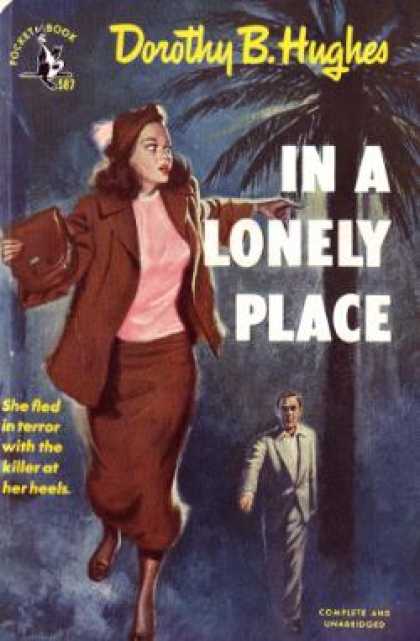It is easy to miss where the title for In a Lonely Place (1950) comes from, but its placement seems hardly non-incidental. In one scene, when Dixon Steele (Humphrey Bogart) is discussing with a detective (Art Smith) and his wife who suspect him of murdering a writer (Martha Stewart) whose novel he is supposed to adapt in to a screenplay, he describes who he think the killer really is and how he did it; ‘ They come to a lonely place…he stops the car and puts his arm around her neck…’ He manages to coerce the detective in to acting out the exact maneuver on his wife, and then persuades him, his gleeful face shadowed with backlighting, to squeeze ‘harder…harder…"
Naturally, Dixon scares the wits out of the detective and his wife. Naturally, he is also a writer by profession. In a Lonely Place is not about a killer or a crime. It is not a whodunit. It is about the gray area that divides poets from psychos.

The director is Nicholas Ray, who would later be one of the original Hollywood filmmakers to be heralded as an Auteur by the French New Wave critics, but in this film, there is no evidence that points to him as the distinctive voice of the film; the screenplay was penned by Edmund North and Andrew Solt, from a story by Dorothy B. Hughes. (That this grim film came from the mind of a woman does not seem too surprising, once one considers how central a role the female perspective on Bogart’s character plays.) The writers crafted a film not just about a writer, but also about the craft of writing; it is Bogart, worn out, pockmarked face and short, intense hair, who completes their story and truly makes the film his own. His Dixon Steele is a has-been screenwriter who did his best work before the war, has a history of casual violence and has now resorted to alcoholism and womanizing. When he is hired to adapt Mildred Atkinson’s book, he does not even bother to read it. Instead, he invites the writer to his home so she can tell him the story, which she does, with great enthusiasm. Steele acts as though he has heard the story a million times before and is not paying full attention; he notices his neighbor, Laurel Gray (Gloria Grahame) spying on him from her apartment window. He escorts Ms. Atkinson to the door at the end of the night, and the camera fades out on her figure as she leaves under his stone archway leading out of his yard.
The very next day, Steele is being questioned in regards to her murder. He insists he is innocent, but his nonchalant manner and the sociopathic accuracy with which he is able to deduce the details of Atkinson’s murder—not to mention his past record—all lead the police to suspect otherwise. Soon Laurel Gray is brought in for questioning and, although she too suspects him of having a sinister character, she soon finds herself in love with Dixon. Dixon, too, seems for once to have real feeling for someone, but two questions remain; did he kill Mildred Atkinson or not? Will he kill again?
In a Lonely Place is often characterized as a film noir, but this label should be taken lightly. It is not pure film noir, as the chiaroscuro is not pronounced enough, the women are not backstabbing dames and the city itself is only seen in glimpses and never despairing urban expressions. Though not a noir rule, the detectives are not the central characters, leaving even the distinction of detective story out of range. In a Lonely Place takes several quintessential noir elements and magnifies them; the witty and bitter dialogue (“You were nice. Not to me. But you were nice.”) provides many cynical chuckles, much needed in relation to the other magnified aspect; the mangled, pathetic realms of the soul. More so, it is about where those realms turn in to art. Bogart’s Dixon is a tormented man who expects no sympathy and gets none, aside from signs of a wasted talent that could only potentially be revived. Towards the end, he is only trying to pull himself together when he falls apart again. Bogart moves as if he doesn’t care what the camera sees of him; and the camera sees everything. It’s perhaps one of the best screen performances by an American actor, free of histrionics and sentimentality.
One of the more curious aspects of In a Lonely Place—and this only in retrospect, almost sixty years on—is the feeling that if it were made today, it may be considered far too silly to be taken seriously. Audiences would find it to be a Tarantino rip-off, with too outrageous dialogue (though I doubt Tarantino would ever be able to write this script), music that is too incessant and obvious. It would be a movie that’s saying nothing unusual; yes, artists are crazy, yes Hollywood corrupts. Next. The simple, often static camerawork would be praised as modest at best. In a Lonely Place is a movie that we must conclude is dated and severely of it’s time. Yet perhaps this is one more reason to see it. And in regards to raw acting, physical, oral and psychological, it is still unparalleled.
(cover of Dorothy B Hughes' original novel, 1947)